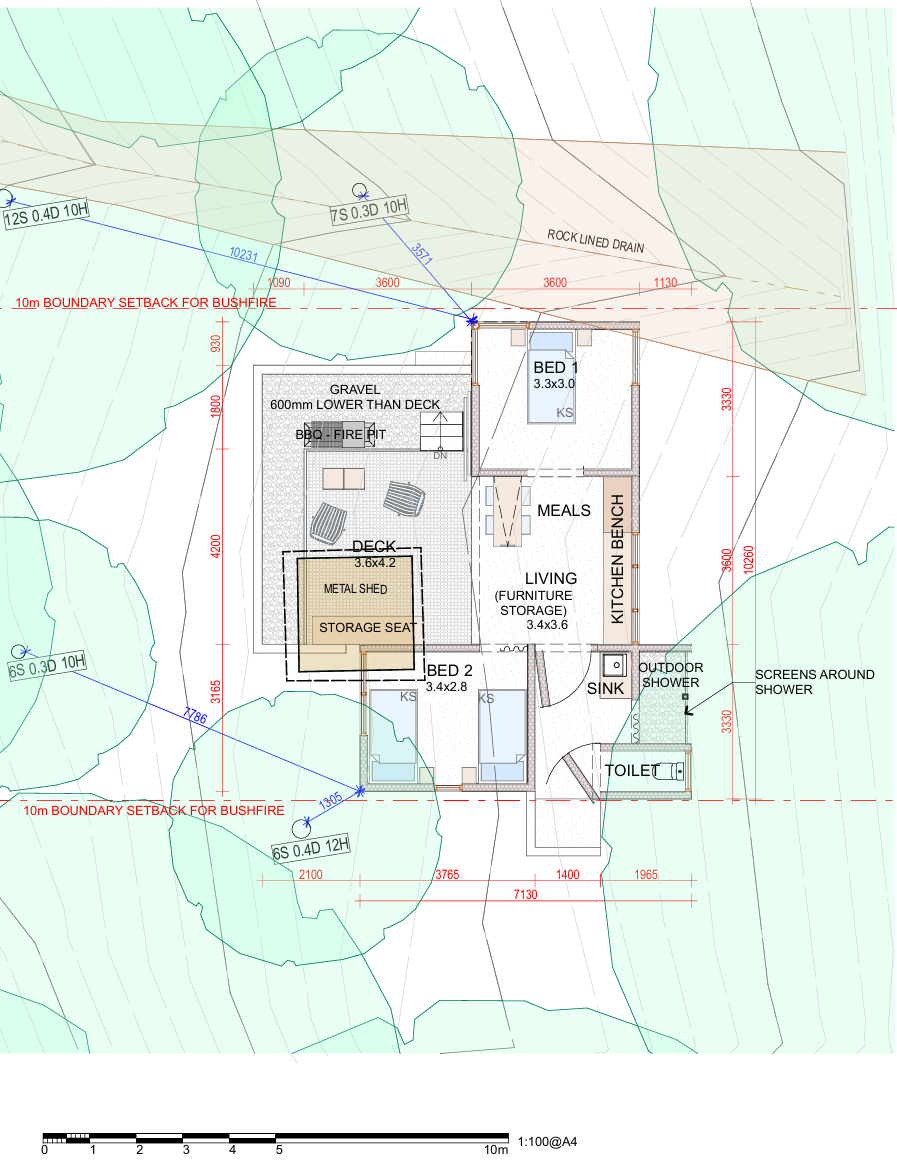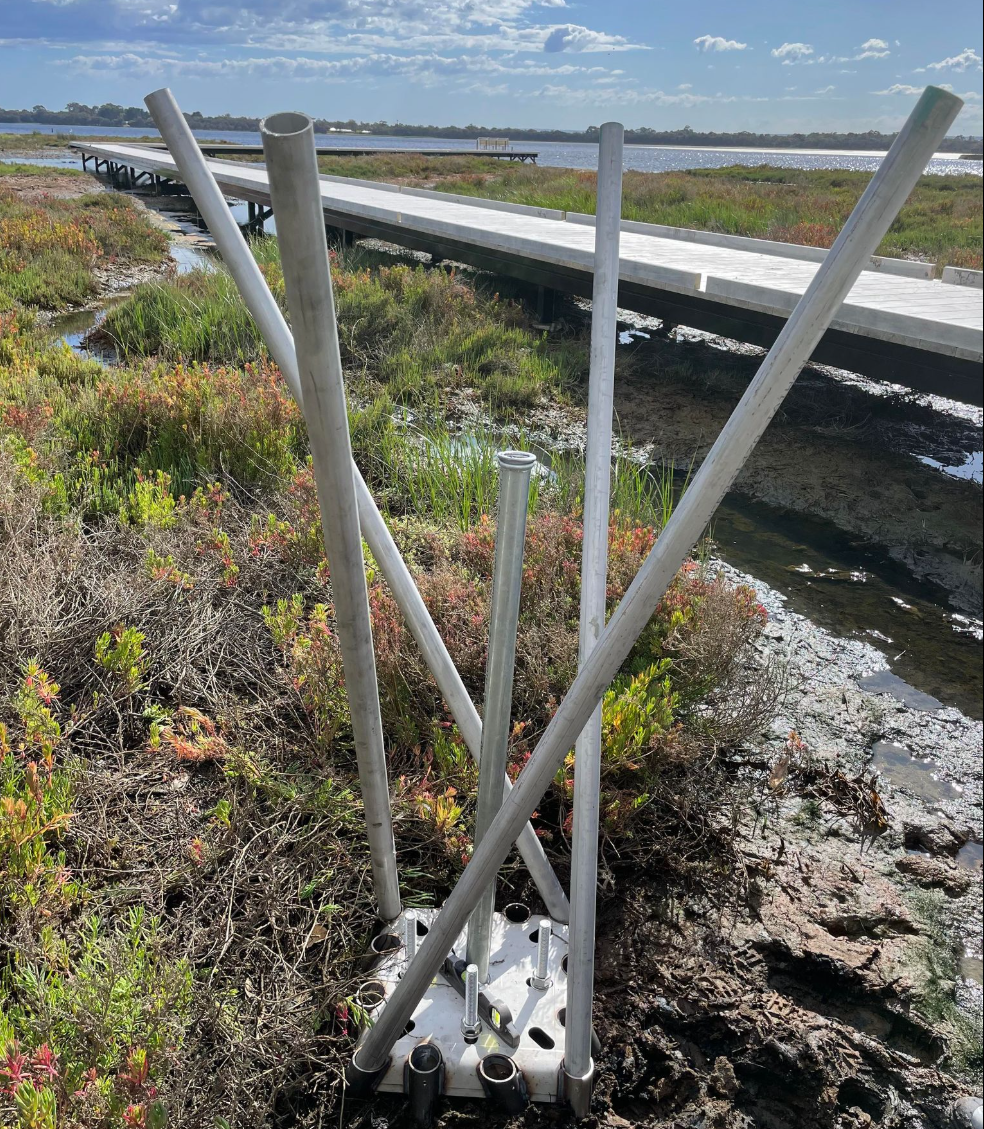The house
The pathway connecting the dwelling and jetty will be sandstone, which is found throughout the land already.

Setbacks and Topography
The house component of the proposal includes the following setbacks: • Dwelling to front boundary (Hawkesbury River): approximately 40sqm to 60sqm • North side boundary: approximately 10m • South side boundary: approximately 10m
In response to the topography of the site, the dwelling will be constructed on piers and surefooting footings, thereby negating the need for any significant earthworks and heavy equipment.

Structural Insulated Panels (SIPs)
Structural Insulated Panels (SIPs) offer several environmental benefits, making them a sustainable choice for construction:
- Energy Efficiency: SIPs provide exceptional thermal performance with high R-values and low U-factors, reducing the need for heating and cooling. This leads to lower energy consumption and reduced carbon emissions.
- Reduced Waste: Offsite factory production of SIPs minimizes job site waste by about 30% compared to traditional stick framing methods.

Minimizing Waste with SIPs
The house will be built using Structural Insulated Panels (SIPs) which will be sized so that they are able to be carried in by two men, thus decreasing the need for heavy machinery. Using them also minimizes waste:
- Reduced Site Disturbance: SIPs are prefabricated, which means shorter construction times and less disruption to the site. This is crucial in environmentally sensitive areas to protect existing vegetation and habitats.
- Factory-Controlled Production: SIPs are manufactured in a controlled environment, which reduces errors and material wastage that often occur on-site.
- Precision Manufacturing: The panels are cut to exact specifications, minimizing offcuts and excess materials.
- Modular Design: SIPs are designed as large, modular panels that cover more area with fewer joints, reducing the amount of material needed and the potential for waste.
- Reduced Job Site Waste: The prefabricated nature of SIPs means less cutting and fitting is required on-site, leading to less construction debris.
- Recyclability: SIPs can be designed for easy disassembly and recycling at the end of their lifecycle, contributing to a circular economy.
- Thermal Performance: Their superior insulation properties mean buildings require less energy for heating and cooling, which reduces the building's carbon footprint.
- Air Quality and Noise Pollution: Faster construction times and fewer deliveries to the site decrease the impact on local air quality and reduce noise pollution, benefiting the surrounding environment.
- Resource Efficiency: SIPs make efficient use of materials, such as oriented strand board (OSB) and expanded polystyrene (EPS), which are both recyclable and often made from sustainable sources.
- Sustainable Forestry: The wood used in OSB for SIPs is often sourced from fast-growing, sustainably managed forests, contributing to sustainable forestry practices.
- Increased Longevity and Durability: Buildings constructed with SIPs tend to have a longer lifespan and require fewer resources for maintenance and repair, reducing long-term environmental impact.

Water Containers
The choice of water containers is so that they can be transported in without the need for machinery.

Surefootings Engineering
The engineering of the house and jetty (where possible, expected to be entirely within the area leading up to, and within, the mangrove area) is using Surefootings. This offer several environmental benefits, especially in environmentally sensitive areas:
- Minimal Site Disturbance: Surefootings require less excavation compared to traditional concrete footings, reducing soil disruption and preserving natural habitats.
- Reduced Carbon Footprint: The production of concrete footings generates significant carbon emissions, whereas Surefootings use fewer materials and produce fewer emissions. By minimizing the need for concrete, Surefootings help lower the demand for cement production, which is a significant source of CO₂ emissions.
- Lightweight Construction: The materials used in Surefootings are generally lighter than traditional concrete, reducing transportation emissions. Less heavy equipment is needed, minimising need for ??? in the mangrove area.
- Quick Installation: Faster installation means less time spent on-site, reducing the overall environmental impact of construction activities.
- Durability and Longevity: Made from corrosion-resistant materials, Surefootings have a long lifespan, reducing the need for replacements and further construction.
- Versatility: They can be adapted to various terrains and soil conditions, making them suitable for sensitive environments without extensive site preparation.
- Reusability: Surefootings can often be removed and reused in other projects, contributing to a circular economy and reducing waste.
- Improved Soil Health: With less soil compaction and disruption, Surefootings help maintain healthier soil ecosystems, supporting plant growth and reducing erosion.

House size and Location
The size of the house has been chosen to minimise impact on soil and water flows as well as the visual impact and required level of clearing.
Location of the house is maintaining existing drainage paths and avoid altering natural water flow. This helps minimize erosion and preserves the natural hydrology of the area.
Create Your Own Website With Webador